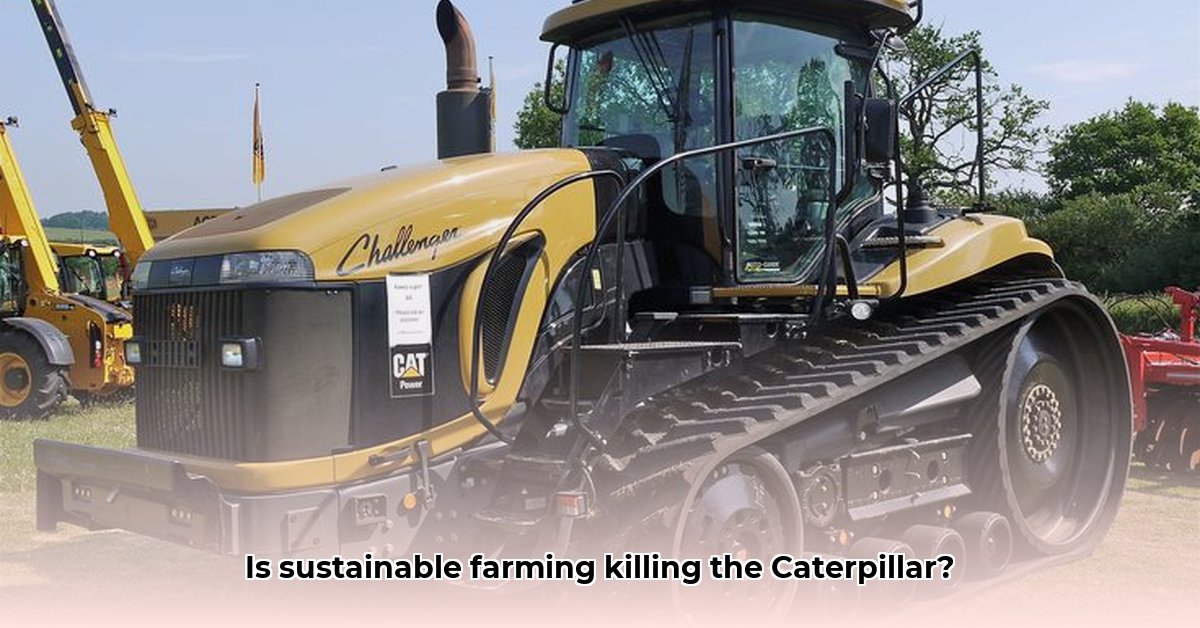
Caterpillar Challenger Tractor: A Giant's Fall and the Future of Farming
The Caterpillar Challenger tractor, once a dominant force in large-scale farming, has been discontinued. This isn't simply a product lifecycle event; it represents a significant shift in the agricultural landscape and a compelling case study in the evolving dynamics of sustainable agriculture. The Challenger’s legacy prompts a critical examination of the interplay between powerful machinery and environmentally responsible farming practices. For more on vintage farm equipment, check out this website.
From Field Domination to Farewell: The Challenger's Journey
The Challenger, particularly models like the 65 with its Mobile-Trac System (MTS), revolutionized farming with its immense power and capacity to cultivate vast acreages daily. However, this power came at a cost. The sheer scale of these machines raised concerns about their long-term environmental impact. While initially lauded for productivity, questions persisted regarding their sustainability.
The sale of the Challenger line to AGCO marked a turning point. AGCO invested in upgrading the tractors with cleaner AGCO Power engines to meet stricter emission standards. Despite these upgrades, the decision to discontinue the line indicates a strategic shift away from this type of high-powered machinery. Several factors likely contributed to this outcome.
The Green Revolution's Impact and the Challenger's Limitations
The Challenger's story highlights a fundamental tension: the compatibility of large-scale, high-powered farming with environmentally responsible practices. Modern agriculture increasingly emphasizes conservation tillage and precision agriculture, which prioritize soil health and minimize environmental damage. The Challenger, in its traditional role, often clashed with this philosophy.
While highly efficient for conventional plowing, the Challenger wasn't readily adaptable to newer, sustainable methods. This lack of adaptability, coupled with evolving industry demands and stringent environmental regulations, likely influenced AGCO's decision to discontinue the line.
Stakeholders and the Challenger's Departure: Winners and Losers
The Challenger's discontinuation has had wide-ranging effects across the agricultural sector. Analyzing the impact on key stakeholders reveals the complex implications of this decision.
| Stakeholder | Short-Term Impacts | Long-Term Impacts |
|---|---|---|
| AGCO | Strategic reassessment of high-power machinery; potential short-term financial impact. | Investment in R&D for sustainable alternatives; shift toward smaller, more efficient machines and precision agriculture. |
| Farmers | Challenges adapting tillage practices; significant equipment replacement costs. | Transition towards precision farming, reduced land use intensity; exploration of alternative, sustainable machinery. |
| Regulators | Ongoing monitoring of agricultural machinery emissions. | Development of stricter regulations and incentives for sustainable farming practices. |
| Researchers | Continued life-cycle assessments of farming machinery. | Increased focus on developing more efficient, environmentally friendly agricultural technologies. |
Sustainable Ag Tech: Charting a New Course
The Challenger's story is not simply about the demise of a successful machine; it's a valuable lesson highlighting the need for a holistic approach to agricultural technology. This approach must prioritize efficiency, minimize environmental impact, and ensure responsible resource management. The future of agriculture hinges on this transition.
The void left by the Challenger presents a significant challenge and opportunity. The agricultural sector must actively explore innovative technologies, potentially focusing on smaller, more adaptable machines better suited to precision farming. The development of efficient and sustainable solutions will shape the future of agricultural machinery.
How to Measure the Long-Term Environmental Impact of Large Agricultural Machinery
Key Takeaways:
- Mechanization and large-scale farming, particularly in regions like China, significantly increase carbon emissions.
- The short-term benefits of increased yields are often offset by long-term environmental consequences, including increased energy consumption and chemical inputs.
- Urbanization may unexpectedly mitigate the carbon footprint of agriculture.
- The type of machinery is crucial; diesel-powered equipment hinders environmental gains.
- Sustainable solutions include clean energy agricultural technology, optimized resource use, and carbon-neutral farming practices.
The Challenger's Legacy: A Sustainability Case Study
The Caterpillar Challenger tractor's legacy serves as a potent illustration of a crucial question: How can we accurately measure the long-term environmental impact of large agricultural machinery? Its story highlights the complexities of balancing agricultural productivity with ecological responsibility.
Beyond simple fuel efficiency metrics, a holistic approach is necessary to assess the full environmental footprint. This involves considering factors such as:
- Greenhouse Gas Emissions: Including those from fuel combustion, fertilizer production, soil carbon loss, and transportation.
- Water Usage: Both direct consumption and indirect effects on water resources.
- Land Use Change: Impacts like deforestation or habitat loss resulting from large-scale mechanization.
- Biodiversity Impacts: The effects of monoculture farming frequently associated with large-scale mechanization.
Data Needs and Long-Term Research
This comprehensive assessment requires the collection of extensive data over extended periods. Short-term studies are insufficient to capture the full impact. Standardized methodologies for assessing the environmental impacts of agricultural equipment are also lacking. Developing a globally accepted framework is essential for accurate and reliable assessments.
A Path Towards Sustainable Agriculture
The Challenger's discontinuation underscores the need for a fundamental shift toward sustainable agricultural practices. This involves:
- Investing in clean energy technologies: Developing and utilizing farming machinery powered by renewable energy sources (electricity or biofuels).
- Improving efficiency: Implementing precision agriculture techniques to optimize resource use and minimize input needs (fertilizers, pesticides, water).
- Promoting sustainable farming practices: Adopting techniques like integrated pest management, crop diversification, and agroforestry to reduce environmental impact.